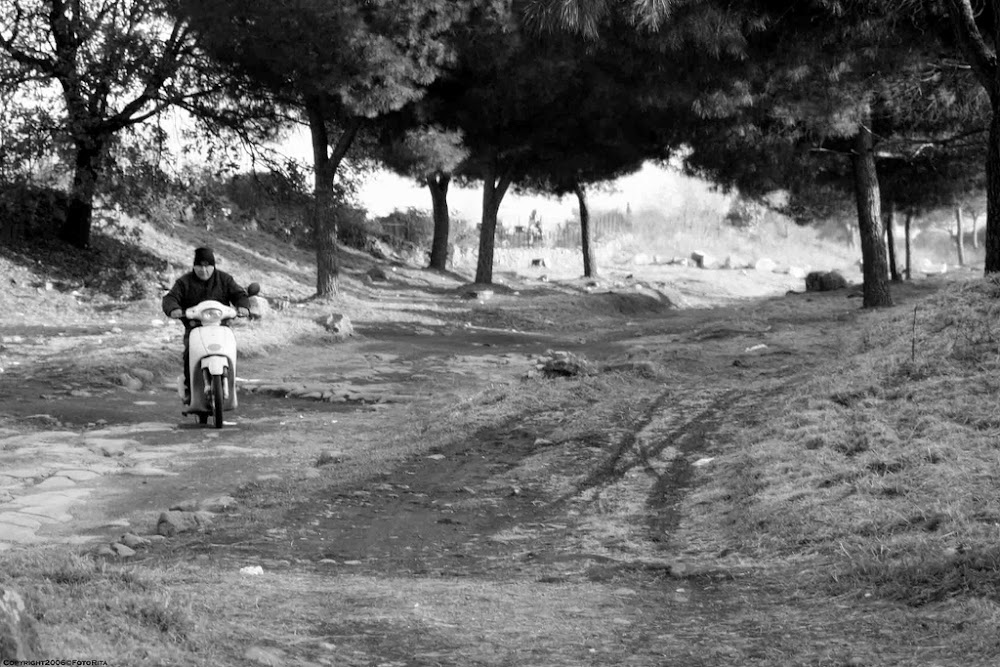Walk data
| Walking distance | 15 km / 9.32 miles |
| Walking time | 3 hr |
Other walks, & more on the way: I've been walking to and from airports for longer than Will Self and the route base will gradually materialise here.
Background & itinerary
Put on the 4th movement of Respighi’s The Pines of Rome, “The Pines of the Appian Way” (15:38), and read on:
This tremendous walk leads you in the wheel tracks (still visible) of no less than a Stuart bishop of Sarum, whose journey along the Via Appia the antiquary Basil Kennett (1674–1715) reported (Romae antiquae notitia) as follows:
The most noble, in all respects, [of the public ways] was the Via Appia, taking its name from the author Appius, the same that invented the Aqueducts… This was carried to such a vast length, that Procopius reckons it a very good five days journey to reach the end; and Lipsius computes it at 350 miles. An account of as much of this way as lies between Rome and Naples, the right reverend the present lord bishop of Sarum has obliged us with in his letters; he tells us it is twelve feet broad; all made of huge stones, most of them blue; and they are generally a foot and a half large on all sides. And presently after, admiring the extraordinary strength of the work, he says, that though it has lasted above 1800 years, yet, in most places, it is for several miles together as entire as when it was first made.

There’s a decent article on Wikipedia, and here are official maps of the route, but it’s all incredibly simple:
- Take a Ryanair to Ciampino, preferably arriving just before sunrise.
- Head SW out of the airport on the main exit road, passing the well-armed but dozy guard.
- Continue straight on (SW) over a roundabout.
- Cross the large Via Appia Nuova on another.
- Continue SW another 350m on the Via dell’Aeroscalo. Be extremely careful on this stretch – the verges are crammed with cars avoiding airport parking charges, and traffic travels fast.
- Turn right/NW onto the Via Appia Antica.
- Walk towards Rome, pausing every few metres to investigate remarkable on- and off-piste monuments, including hordes of tombs (check out Bill Thayer’s collection of Roman funerary resources), a nifty emporium, the Casal Rotonda and the Villa of the Quintili. When we went the latter was only officially open, but the fence is, ahem, not insurmountable. Remember, also, to look behind you to the Alban Hills and to your right to the Claudian Aqueduct.
- At the T-junction just after the church and catacombs of San Sebastian, take the private road marked No Entry to the Catacomb of Callixtus. This takes you past a splendid hill-top convent amid fields with, if you are lucky, some sheep whose milk is converted into an excellent cheese. It also avoids oppressive traffic on the footpath-free Via Appia proper.
- On exiting the convent grounds at the church of Domine Quo Vadis (on the other side, check the remarkable sign to the “Santuario Divino Amore”) carry on along the main road and enter the Aurelian wall through the splendid St Sebastian gate, currently guarded by Romanian gypsy windscreen-wipers:
The Porta Capena in the Servian Wall no longer stands, so this is the closest you’ll get to imagining Spartacus’ last hangout:[1]Movie continuity goof which I don’t think anyone else has noticed, probably because they’re so immensely cheered to see Kirk Douglas perish: Varinia and Batiatus shouldn’t have seen Spartacus at all, because Aquitania and Gaul – their alleged destination – lie to the north. A theory and a sequel: Varinia is lost, and Batiatus hopes to keep Gracchus’ money and sell her to some Libyans down south, the swine. - Keep walking and after a while you will pass the Caracalla baths to the left and then arrive at the Circus Maximus and, if you fancy a good lunch in the company of bulky African mafiosi, the UN’s Food and Agriculture Organization.
There are public fountains every once in a while, but food stops are concentrated at the northern end of the walk and tend to be pricey and not very good. This, the first bar, is half-way along, just after the Capo di Bove baths and before the tomb of Cecilia Metella, Crassus’ daughter. The terrace is expensive and the cakes are dry and mediocre, but the garden round the back is pretty, and it does the job. The food shop almost opposite is more interesting.
You can do this at a moderate pace with a couple of beer stops in four hours, but even if you’re only here for the weekend the wealth of stuff you’ll encounter justify several hours more – despite massive illegal house-building and other construction, this landscape has still fared far better than, for example, the Granada plain.
If however you can’t be arsed to walk, the only sensible way to get in and out of town is the train from Roma Termini to Ciampino for about 1.30€ in 15 minutes every 10-15 minutes or so till around midnight and then again from around 5, and there’s a half-hourly shuttle bus to the airport. If you somehow manage to arrive at 3 in the morning, feign a heart attack – the ambulance will get you to town and is cheaper than the taxi.
KPICASA_GALLERY(FollowthebaldieAppianWay#Gv1sRgCIWco_a9m9Ht8gE)
[
Originally published elsewhere in 2011.
]
Anecnotes
Similar posts
Back soon

Comments